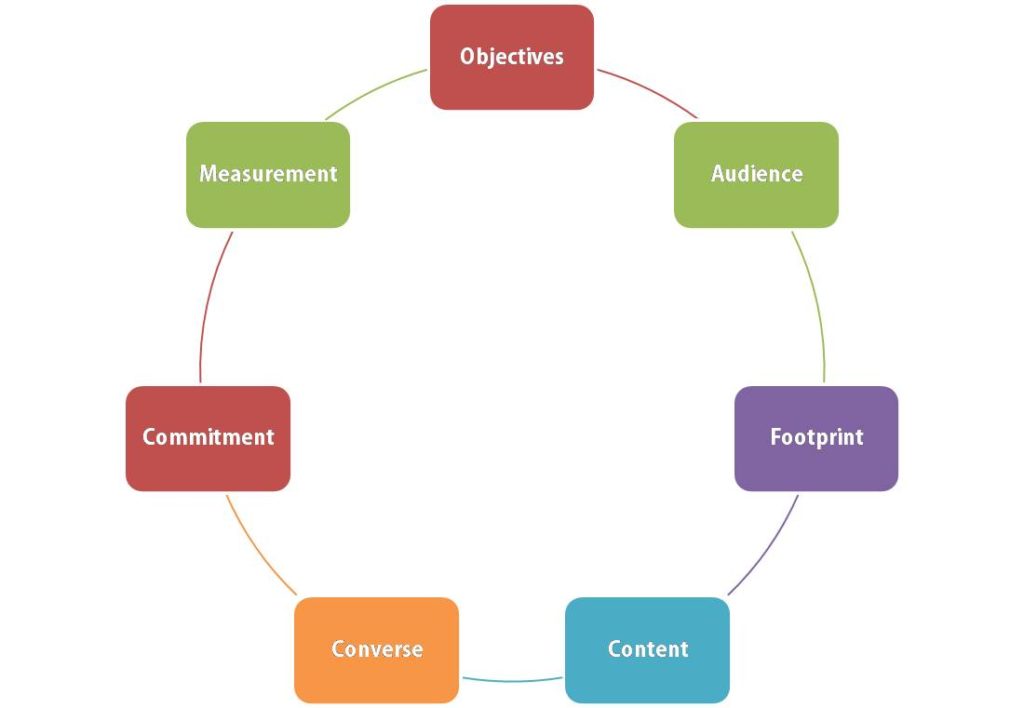
When we think of “strategy”, we often think of a document that is written, placed on a shelf, and forgotten. But in a volatile, uncertain, complex and ambiguous (VUCA) world, strategy must come closer to operations for every business. In fact, we must learn to operationalise strategy in new, responsive and scalable ways. And in almost every instance, that strategy must be digital – or more importantly, digitalised.
The continuous digital strategy framework
As we move strategy off the shelf, it becomes actionable. This means that each step needs to be articulated and validated. Here is how we work this through:
Objectives: You have to have serious objectives. Your research and insight process will have delivered you a challenge – a problem to solve – and out of that you or your client will have laid out some objectives which need to be met. These objectives may be “fluffy” objectives like “awareness” or “reach” or they may be harder – like “increasing sales 20%” or “200 new customers”.
Audience: Once you know what the company or client expects, it’s time to turn your attention to the need states of your audience. What do they want? What do they expect? What do they aspire to? What need is unmet? What do your customers look, smell and taste like? It’s time to get up close and personal with the folks who pay your bills! As a deliverable, you might develop a series of customer personas.
Footprint: Now that you know your audiences in their pungent granularity, you now need to understand their behaviour. Where do they go? What do they do? Where to they spend time and why? This is about walking a mile or two in their shoes. But it also a chance to match the footprints of your brands/products. What overlaps? What doesn’t? Where are the opportunities? And where are the touchpoints that will become valuable as your project grows. As a deliverable, this is where you work to develop customer journeys and use cases.
Content: Brand storytelling and messaging, themes and campaigns drive the focus of your content. At this step we are looking for the ways that you can emotionally engage and entertain your audiences – linking key brand and product messaging to the customer journeys. This might include website copy, templated (but engaging) email copy, newsletters, thought leadership and so on. As a deliverable this often takes the form of a content calendar that not only covers key customer touch points, but also articulates cornerstone content, campaign and thematic messaging.
Converse: What needs to be done to progress a customer conversation? At this point the strategy should address the development of shareable content, policies relating to social media and interaction and the interaction design that supports customer engagement. This could include customer contact planning, chat automation and lead scoring and nurturing. From a deliverables point of view, this could include tone of voice guidelines, automated customer journey paths and messaging, the scoring of leads and more.
Commitment: Once we begin conversing the strategy should now consider what success might look like. How do we know when our objectives have been reached? What is the customer commitment that we seek to validate that we have reached the required stage of the customer journey? For example, we may aim to turn our prospects from “unknown to known” – which means we are seeking an email address or contact number.
Measurement: We often think that measurement is difficult. It’s not. What is hard is committing to the numbers and to the metrics. If we have done the hard work of aligning our project objectives with the overall strategic objectives of our businesses, then much of this falls in place. But we also need to follow this through each of the other steps. For example, which audiences are important (or are influential) for your brand/product? Measure it. How much time do they spend on the web and on which sites? Measure it. Which pieces of content will drive engagement (and which pieces need to change and evolve as your project grows)? Measure it. How far do your conversations echo across the web? Measure it. What are the intangibles – and what can be substantiated via research? Measure it.
Now, once you have completed an iteration cycle, race through it all again. Pool your learnings from each step and drive them back through the process. Make your brand better. Make your customer experience more profound. Refine, substantiate and evolve.